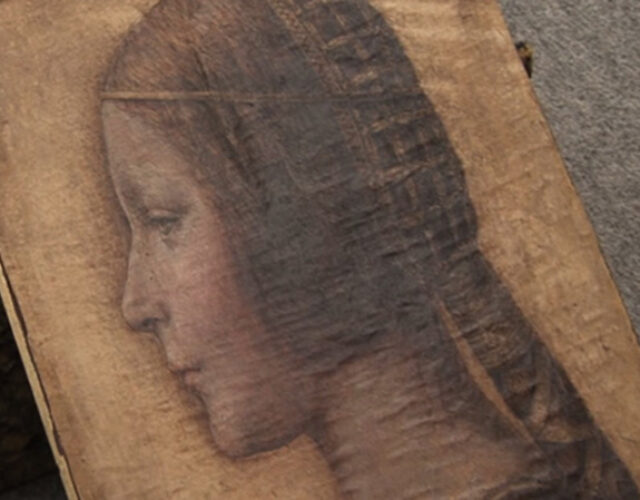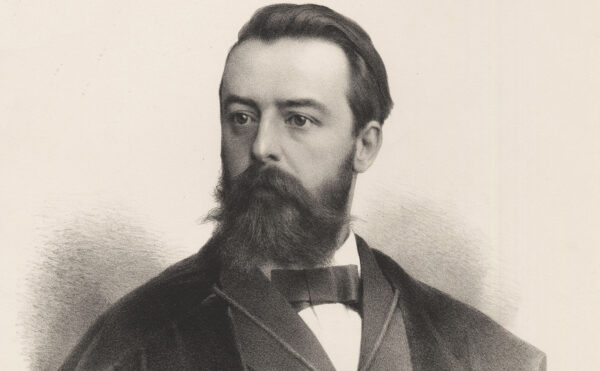In 1482 the 30-year-old Leonardo da Vinci offered his military services to Ludovico Sforza, the duke of Milan. Leonardo, an expert on machines of war and industry, as well as one of the world’s greatest artists, spent the next 17 years under the patronage of the ruling Milanese duke. His studies during this time included flying machines, anatomical studies, war engines, submarines, architecture, and about six completed works of art, including The Last Supper, which revolutionized art in Renaissance Europe.
Fast forward to the 21st century and an August 2008 article in the New York Times that introduced readers to an obscure work of art. Now known as La Bella Principessa, the small portrait is of a young woman in profile, about 14 years old, drawn with chalk, ink, and dye on sheepskin and mounted on an old oak board. While its exquisite beauty is undeniable, of far greater interest was the question of the unknown painter. Was it or wasn’t it the work of Leonardo da Vinci?
The first official mention of this portrait appears at a 1998 Christie’s auction. The buyer, New York art dealer Kate Ganz, purchased the piece, which was listed as an early 19th-century German Romantic portrait, for $19,000. In 2007 Canadian-born collector Peter Silverman purchased it from her on behalf of an anonymous Swiss collector for $21,850. The close profile view and line strokes suggested an earlier provenance, so Silverman asked Renaissance scholars to look at the portrait. Soon the “L” word was buzzing around the art world. Could it be? Various Leonardo scholars suggested it just might be. But first science would have to meet art in a scholarly dance of authentication.
Giammarco Cappuzzo, an art consultant and a friend of Silverman’s, sent a tiny slice of the sheepskin to the physics department at the University of Zurich’s Institute for Particle Physics for carbon-14 dating. The results conclusively dated the vellum to between 1449 and 1656 (Leonardo died in 1519). Yet while the date might fit, the material did not. Leonardo left behind many beautiful drawings and some paintings, but this particular artwork was an anomaly: a formal portrait on vellum, or sheepskin, a material used for manuscripts and one that Leonardo had never been known to use for his formal portraits.
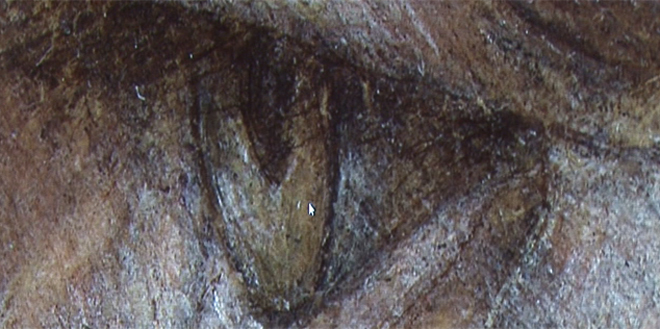
As a professor teaching a course on Leonardo and a producer of a PBS limited-edition series—Science+Art—exploring the intersection of science and art, I wanted to know more. What better way to illustrate the meeting place of science and art than through the authentication (or not) of a possible Leonardo. Either way, I knew the footage would be compelling. I asked my series adviser Martin Kemp, an Oxford art historian and one of the foremost Leonardo scholars, if we should look into this. Kemp had already done preliminary research and had even been asked to examine the real thing, but had refused to act as a paid authenticator, a role that ethically would have placed him in an awkward position. But now, with the Science+Art project underwriting all of Kemp’s expenses, he agreed. The October after the New York Times article appeared, I gathered my director of photography, Vic Losick, and Kemp—and set off for France to see scans of the artwork firsthand.
Simulacrum of a Young Lady
Our first stop was the office of Lumiére Technology, located in a lovely interior courtyard along Paris’s Left Bank. There we met Pascal Cotte, the company’s chief technical officer and cofounder. Cotte, an optical engineer by trade, invented the first 13-band multispectral camera, which can scan and digitize images to an extraordinary resolution of 420 million pixels. Contemporary professional cameras have a resolution of 16 million pixels. In addition, the multispectral portion of Cotte’s camera allows for scanning beyond the capabilities of the human eye—from ultraviolet to infrared. These scans above and below the visible spectrum reveal the normally invisible layers of sketches behind the painting and in much greater detail than can an X-ray. With the ultraviolet scans a conservator can also differentiate original work from subsequent restorations on that work. Conservators can not only see how a painter built up his painting from an initial sketch; they can also isolate the chemical components of the paints and pigments used, thus helping date a painting. The scans take only a few hours at most, as opposed to other methods of digitizing art in detail, which can take days, turning this multispectral camera into a powerful tool for conservators of art and for museums.
Cotte, no stranger to da Vinci’s work, is responsible for the 2004 “virtual unvarnishing” of the Louvre’s Mona Lisa. He also scanned Lady with an Ermine, which now hangs in the Czartoryski Museum in Kraków, Poland. When we arrived, he showed us Lumiére’s work on these two famous paintings. In the Mona Lisa we saw how da Vinci changed the hands and the delicacy of the veil over her hair for the final version. Women of that time wore such a veil when pregnant, so perhaps the woman with the famously enigmatic smile was with child. On the scans of Lady with an Ermine we saw a fingerprint. Kemp commented that Leonardo worked with his hands all the time, as many artists do, their fingers not only touching and holding the canvas but also coaxing paint and other materials across it.
Finally Cotte revealed the digital image we had traveled all this way to see: the portrait of the young woman, which had been scanned at about 4,000 pixels per square millimeter. That resolution meant the scans could be examined in great detail. At that time she was named Profile of a Young Fiancée, as she was thought to be a sort of match.com profile of the Renaissance—a portrait made to show an interested fiancé the attractiveness of his potential bride. Providing such portraits before marriage was a common practice during the Renaissance. But as we looked more closely, we began to hold our breath.
On the left side of the portrait was an uneven edge cut not by scissors but by a knife. We could even see where the knife had slipped. We also noticed three small holes with tattered edges on the left side of the sheepskin, suggesting that this portrait might have been the cover of a handmade bound booklet.
“That’s incredibly interesting,” Kemp said. “This could have been the frontispiece for a manuscript of Petrachian-type poems written in honor of this young woman. That would explain the sheepskin.”
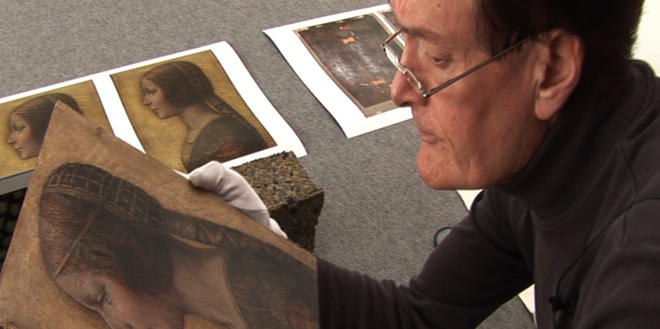
We examined the portrait in greater detail, starting with the woman. Creating skin tones on a yellowish sheepskin, or vellum, had to be different than painting on a white canvas, Leonardo’s usual style. Cotte told us that scans of the skin-tone areas revealed white lead, red, and green pigments, but no yellow; instead the artist used the vellum itself as the source for the yellow of the skin tones, a technique Kemp suggested might have been learned from Jean de Perréal, a manuscript artist from Paris. A note in Leonardo’s Codex Atlantius contains the intriguing hint that he wrote to de Perréal requesting information on how to create realistic skin tones on vellum.
Her eye—in a shade of amber provided solely by the color of the sheepskin—was framed by tiny wisps of eyelashes drawn in precise, delicate lines with sharply pointed, hard, black chalk. The design on the dress and the hairs on the woman’s head were also drawn with chalk. The coloring of the skin, hair, and dress, however, was done with organic dyes.
As we explored more of the portrait’s handiwork we found left-handed “hatching”—tiny parallel lines used for shading, which are uniquely Leonardo’s. Although some of Leonardo’s Milanese and Florentine followers tried to emulate his hatching style, none came close to his precision. Cristina Geddo, an Italian expert on the works of Leonardo’s followers, confirmed that there were no left-handers in that group and, after studying scans of the portrait online, told Kemp that none of the followers ever reproduced the same sublime results as Leonardo.
Further evidence for consideration was the young woman’s dress, revealing her to be an upper-class Milanese lady of the late 15th century. The greens, reds, and whites of the dress represent the colors of the ruling Sforza family, while the elaborate knot-design detail on the dress is typical of design details favored by Leonardo. Her hair was arranged in a style created by Beatrice, the young wife of Ludovico Sforza, the duke of Milan and Leonardo’s patron, and was called a coazzone, or plait.
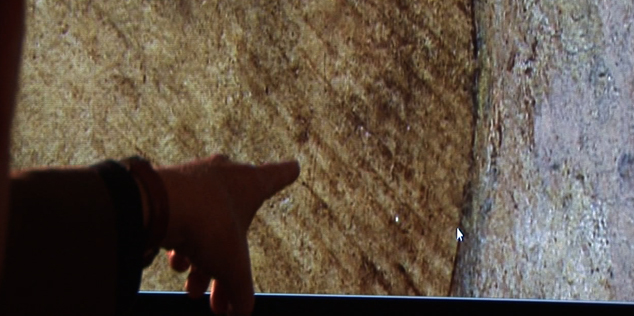
“When something like this comes up, the first thing you think is that perhaps it is too good to be true,” Kemp said after studying the high-resolution scans. “I am usually very cool when I see something, because you can let your enthusiasm run away with you.” His response to the drawing’s earlier 19th-century attribution was, however, emphatic: “No way!”
To the Vault
Our next stop was Switzerland—to see the portrait itself. We were told only that we were going to “the vault.” En route we puzzled over where exactly the portrait was being stored. In the basement vault of a bank? In a safe deposit box? We were wrong: the portrait was stored in an anonymous warehouse, in a large, unmarked wooden box, well packed for shipping. Unpacking her was an ordeal. The big wooden box had to be unscrewed, which took two workmen about a half hour. The portrait was packed in a larger wooden frame to hold it in place for shipping, surrounded by Styrofoam and wrapped carefully in tissue—all of which needed to be dismantled. Finally, with everyone wearing white gloves to protect against dirt and grease from human skin, Cappuzzo put the Profile of a Young Fiancée into Kemp’s hands.
The examining room, in shades of gray, provided a strong contrast to the softness and subtlety of the drawing. Before we left for Paris, Kemp told me that over the past 30 years he had seen many works owners hoped would be Leonardos; of them all this was the first serious possibility. Now in the vault, with the work before him, he pulled out a jeweler’s glass and began his close examination. He quietly studied the portrait for what seemed to us like hours. As we were filming, I kicked Vic Losick, the director of photography, whispering “focus, focus.” But he was in focus; his camera simply captured the extraordinary refinement and softness of the work. Finally Kemp put the drawing down and spoke. His first impression, he said, was of beauty filled with signs of Leonardo, corroborated by the technical evidence provided by the scans. “She has a melting subtlety,” he said, marveling at how much softer and more delicate than the digital scans the portrait was in reality.
Despite the visible bumps and restorations brought about by its age, he remarked on the good condition of the portrait. “This woman is 500 years old. If you or I looked this good after 500 years, we’d be doing a good job.”
Finally, Kemp addressed the question we had been waiting for him to answer. Was it a Leonardo original or not?
He took forever, but finally he said it: “The technical evidence says it is not a forgery.” He told us that acceptance would not happen overnight. However hard he worked on the intellectual context and patronage, however well the science corroborated the evidence, there was still another factor: “There is that element where you just have to say, ‘that is just fantastic and it’s the real thing.’ And having looked at it closely, I am prepared to say that I think it’s fantastic and it’s the real thing.”
Who’s That Girl?
Kemp’s research suggested the young woman had graced the sheepskin cover of a manuscript of poems about her. This finding, combined with her obvious beauty and her dress and hairstyle suggesting her place in the upper class of Milan in the late 15th century, led him to rename her La Bella Milanese. Some complained that name made her sound like a veal chop. When new research revealed a more somber purpose to the portrait, she was renamed La Bella Principessa.
Supposing her to belong to the Sforza family based on her green, red, and white clothing, Kemp identified five women in the court as possible models. One of the five was Ludovico Sforza’s wife Beatrice, but a painting known to be of Beatrice shows a different woman. Another was Isabella of Aragon, the wife of Ludovico’s nephew Gian Galeazzo, but photographic evidence of a painting of her shows differences. The story was similar for Sforza’s niece Bianca Maria, painted by Ambrogio da Predisa in 1493. His other niece, Anna, remained a possibility, as did another relative.
According to Kemp, in 1489 Ludovico legitimized his daughter Bianca, by his mistress Bernardina de Corradis. The next year he betrothed Bianca to Galeazzo Sanseverino, commander of Ludovico’s armies, and the two married in 1496. Bianca died a few months after her marriage of what is believed to have been an ectopic pregnancy, at about 14 years of age. Beatrice, Ludovico’s wife, only a little older than Bianca, wrote to her sister about her friend’s death:
The portrait features the young woman in somber clothes rather than in the celebratory ones suitable to a wedding, suggesting her family commissioned the manuscript and painting in memory of Bianca after her death rather than in celebration of her marriage.
The final word on the status of La Bella Principessa remains to be said. After his study of the portrait Kemp said: “At the end of the day it has got to survive on the ‘wow’ factor. . . . It has got to do that over a long period of time.” But not all Leonardo scholars and art curators are yet on board. Carmen Bambach of the Metropolitan Museum of Art in New York City, who as of this writing had not seen the actual drawing, is not convinced. However, several other Leonardo scholars agree with Kemp, including Carlo Pendretti, a Renaissance art historian at UCLA; Alessandro Vezzosi, head of the Leonardo da Vinci Museum in Vinci; and Cristina Geddo, an expert on Leonardo’s followers. Meanwhile Kemp is continuing with his work on the portrait and says the scholarship on La Bella Principessa as a Leonardo continues to fall into place.
The authentication of the Leonardo would not have happened without the support of the Société and a Dreyfus Foundation Special Grant.

